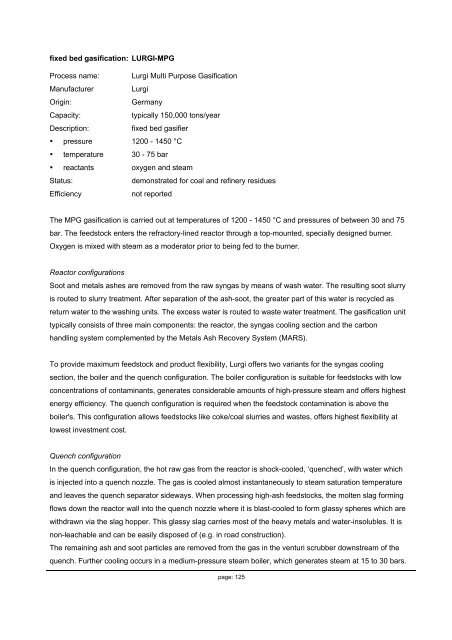Adding gas from biomass to the gas grid - SGC
Adding gas from biomass to the gas grid - SGC
Adding gas from biomass to the gas grid - SGC
- No tags were found...
Create successful ePaper yourself
Turn your PDF publications into a flip-book with our unique Google optimized e-Paper software.
fixed bed <strong>gas</strong>ification: LURGI-MPGProcess name: Lurgi Multi Purpose GasificationManufacturerLurgiOrigin:GermanyCapacity:typically 150,000 <strong>to</strong>ns/yearDescription:fixed bed <strong>gas</strong>ifier• pressure 1200 - 1450 °C• temperature 30 - 75 bar• reactants oxygen and steamStatus:demonstrated for coal and refinery residuesEfficiencynot reportedThe MPG <strong>gas</strong>ification is carried out at temperatures of 1200 - 1450 °C and pressures of between 30 and 75bar. The feeds<strong>to</strong>ck enters <strong>the</strong> refrac<strong>to</strong>ry-lined reac<strong>to</strong>r through a <strong>to</strong>p-mounted, specially designed burner.Oxygen is mixed with steam as a modera<strong>to</strong>r prior <strong>to</strong> being fed <strong>to</strong> <strong>the</strong> burner.Reac<strong>to</strong>r configurationsSoot and metals ashes are removed <strong>from</strong> <strong>the</strong> raw syn<strong>gas</strong> by means of wash water. The resulting soot slurryis routed <strong>to</strong> slurry treatment. After separation of <strong>the</strong> ash-soot, <strong>the</strong> greater part of this water is recycled asreturn water <strong>to</strong> <strong>the</strong> washing units. The excess water is routed <strong>to</strong> waste water treatment. The <strong>gas</strong>ification unittypically consists of three main components: <strong>the</strong> reac<strong>to</strong>r, <strong>the</strong> syn<strong>gas</strong> cooling section and <strong>the</strong> carbonhandling system complemented by <strong>the</strong> Metals Ash Recovery System (MARS).To provide maximum feeds<strong>to</strong>ck and product flexibility, Lurgi offers two variants for <strong>the</strong> syn<strong>gas</strong> coolingsection, <strong>the</strong> boiler and <strong>the</strong> quench configuration. The boiler configuration is suitable for feeds<strong>to</strong>cks with lowconcentrations of contaminants, generates considerable amounts of high-pressure steam and offers highestenergy efficiency. The quench configuration is required when <strong>the</strong> feeds<strong>to</strong>ck contamination is above <strong>the</strong>boiler's. This configuration allows feeds<strong>to</strong>cks like coke/coal slurries and wastes, offers highest flexibility atlowest investment cost.Quench configurationIn <strong>the</strong> quench configuration, <strong>the</strong> hot raw <strong>gas</strong> <strong>from</strong> <strong>the</strong> reac<strong>to</strong>r is shock-cooled, ‘quenched’, with water whichis injected in<strong>to</strong> a quench nozzle. The <strong>gas</strong> is cooled almost instantaneously <strong>to</strong> steam saturation temperatureand leaves <strong>the</strong> quench separa<strong>to</strong>r sideways. When processing high-ash feeds<strong>to</strong>cks, <strong>the</strong> molten slag formingflows down <strong>the</strong> reac<strong>to</strong>r wall in<strong>to</strong> <strong>the</strong> quench nozzle where it is blast-cooled <strong>to</strong> form glassy spheres which arewithdrawn via <strong>the</strong> slag hopper. This glassy slag carries most of <strong>the</strong> heavy metals and water-insolubles. It isnon-leachable and can be easily disposed of (e.g. in road construction).The remaining ash and soot particles are removed <strong>from</strong> <strong>the</strong> <strong>gas</strong> in <strong>the</strong> venturi scrubber downstream of <strong>the</strong>quench. Fur<strong>the</strong>r cooling occurs in a medium-pressure steam boiler, which generates steam at 15 <strong>to</strong> 30 bars.page: 125
















